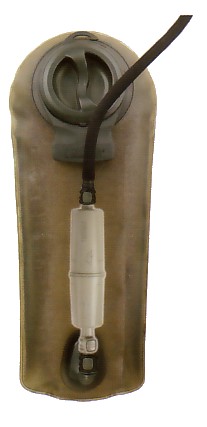CamelBak/MSR Military Inline Filter Product Specifications

Intended use: Military
personnel.
Inline
Filter Physical Specifications:
General Description:
The Camelbak/MSR Inline
filter consists of a bacteria and protozoa rated hollow fiber filtration module
permanently
attached to a high capacity, high kinetic reaction rate granular
activated carbon bed. The filter is intended to be
used for 300 L of field water
and then discarded. It is made from potable water quality materials.
Volume: 0.15
Liters (9.1 in3)
Weight: 65 g
(2.25 oz) when dry before use.
Size: 191
mm (7.5 in) long x 42mm (1.65 in) diameter
Color: US
Army Foliage Green.
Hydration System compatibility:
The filter will utilize the CamelBak HydroLink Modular Attachment System
and interconnect with CamelBak Hydration
systems using HydroLink fittings.
The filter will be supplied with a male and
female Hydrolink hose fitting which will allow
the user to install the
filter in any hydration system using an approximately 6mm (ľ in) ID drink tube.
The inline filter is to be installed between the hydration reservoir and the
bite valve hose within the hydration pack. Inlet
of the filter is female.
Instruction Manual:
Instructions are included. Instructions include installation, use, cleaning,
storage, and troubleshooting.
Filter Performance Specifications:
Biological removal:
Tests performed per the U.S. EPA Guide Standard and Protocol for Testing
Microbiological Water Purifiers, 1987 by
independent test laboratory show that
the filter meets the requirements for removal of bacteria and protozoa. This
test
was performed with Type 2 challenge water:
|
Biological Hazard |
Challenge
Concentration |
Minimum Log
Reduction |
|
Giardia
or 4 -6 Ķm spheres |
106 oocysts/L |
3 |
|
Klebsiella
terragena |
107 cfu/100mL |
6 |
Chemical removal:
The granular activated carbon used in the filter is ideal for the removal of
halogens (such as chlorine or iodine which
are commonly used for chemical
treatment of drinking water). This allows the user to chemically treat field
water (to
kill all viruses) and drink taste free, safe, water within minutes of
treatment. Minimal dwell time is required as the
chemical treatment does not
need to kill either bacteria or protozoa.
Chlorine removal tests show that with a 4ppm Chlorine challenge and a
400ml/minute flow rate the chlorine is reduced
to .6ppm initially and to 1.5ppm
at the end of 300L of treated water. Decreased flow rates or intermittent flow
will increase
the removal.
Turbidity removal:
The filter turbidity removal has been tested to 300 liters. Turbidity capacity
is tested with U.S. EPA Type 2 challenge
water (32 NTU). Cleaned water had a
maximum turbidity of 0.5 NTU. Back flushing of the inline filter was required 3
times in the 300 liters. Back flushing is easily performed by the user in the
field and does not require special equipment
or a clean water source.
Flow Rate and Pressure Drop:
The filter will flow 400mL/minute at a pressure drop of 9 KPa (1.3 psi) or less
when new. The filter should be back-flushed
when the pressure drop at 400 mL/min
reaches approximately 20 KPa (~3 psi) but can be backflushed any time the user
likes. Back-flushing is most effective if done with the filter disconnected from
the hydration bag.
Environmental
requirements:
The filter is a rugged product capable of performing in its intended markets.
Lab and field testing have been performed by
both CDI and CamelBak to ensure
that the filter meets the customerís needs.
Filter Storage: Filter can be
stored at temperatures up to 60C or down to -40C. If the filter has been used it
should have
excess water blown out (by mouth or similar, not with compressed air
blast) of filter prior to freezing. Storage of filter wet
can cause significant
bio-growth within the filter.
Filter use: The filter is
effective to use at all temperatures below 50C and above the temperature that
causes freezing to
occur in the membranes or housing.
Durability:
The filter can withstand a 1 m (39 in) drop to concrete in any orientation
before being installed in the hydration system.
After installation in the
hydration system the durability will increase but is dependent on the type of
hydration system.
The filter can be sat on by a
135Kg (300 lb) person without sustaining any damage.
Each filter is pressure tested to
100 KPa (14.6 psi) internal pressure.
